I cruise to Alaska every summer, and I always see passengers making the same few rookie mistakes.

After five cruises to the 49th state, I’m familiar with the ins and outs of Alaska cruises. I know exactly what I should pack, which excursions I should book, and what to do in each cruise port.
For most first time cruisers to Alaska, however, this is not the case. Many of these passengers make rookie mistakes that can easily be avoided, whether packing incorrectly or unintentionally missing out on breathtaking views.
As someone who sails to Alaska often, I wanted to share the most common mistakes I see cruisers making on Alaska cruises so that you know what to expect.
Be sure to avoid these mishaps to ensure your cruise is as memorable and stress free as possible.
Booking shore excursions in every port
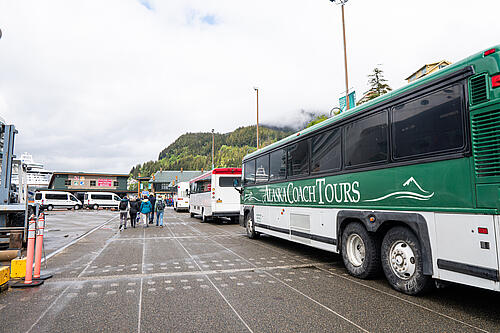
Alaska cruises offer some seriously intriguing shore excursions, from whale watching tours to helicopter rides over glaciers. There’s no doubt these excursions lead to an unforgettable day, but it’s not necessary to book an excursion in every port.
One advantage of Alaska’s small ports is that they offer plenty to do without needing an excursion or transportation from one place to another.
Most ports have walking trails, downtown shopping, and museums within walking distance to the cruise port. You can visit raging waterfalls, hike through the rainforest, and learn more about the state’s culture without spending much (if anything) extra.
Related: Royal Caribbean Alaska cruise guide
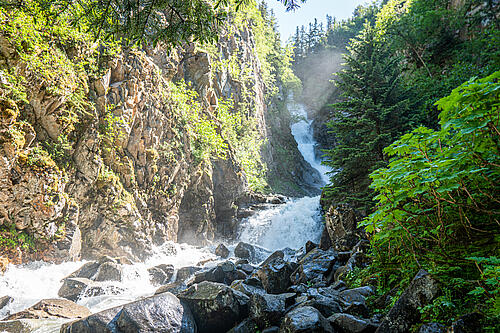
If you want to venture away from downtown, you can always book shuttles to destinations like Mendenhall Glacier in Juneau or the Fortress of the Bear rehabilitation center in Sitka. Booking transportation on your own versus as part of a shore excursion not only gives you more flexibility, but lower prices, too.
Shore excursions are great for activities you cannot experience as easily on your own, such as kayaking tours and flightseeing experiences, but you can experience a lot of the state’s highlights on your own as well.
Worrying too much about the weather
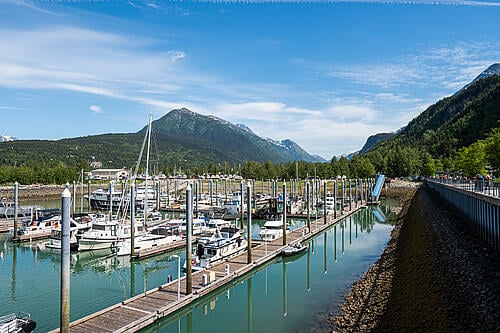
“It’s going to rain every day!”
I’ve heard this sentence more times than I can count from those visiting Alaska for the first time. While preparing for an Alaska cruise, it’s tempting to check the weather forecast, but take it with a grain of salt.
Alaska’s weather can change rapidly from one moment to the next. At 7AM you may find yourself freezing with high winds and rain whereas at 1PM you might have to take off a layer because it’s too hot.
Related: When is the best time to cruise Alaska? Month-by-month guide
I always recommend packing layers for an Alaska cruise for this very reason. If you have the appropriate layers (a base layer, warm layer, and waterproof layer), you will be prepared for any type of weather condition.
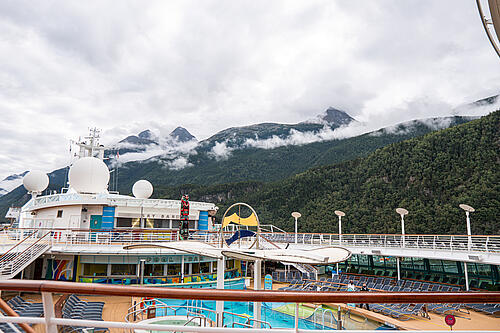
It’s important to remain flexible, nonetheless, and to mentally prepare yourself to feel uncomfortable—it’s unlikely you’ll encounter ideal weather conditions in every port.
On a recent visit to Juneau, for example, I rode a bicycle to Mendenhall Glacier. On route to the glacier we rode in favorable conditions, with temperatures in the mid 60s and a slight breeze.
On the way back, we encountered heavy rainfall and were drenched by the time we made it back downtown. Sure, we were uncomfortable and our clothes were beyond filthy, but it didn’t ruin our cruise experience by any means.
Worrying about the weather will cause you unnecessary stress. As long as you wear and/or pack appropriate layers for each port day, everything should go smoothly.
Packing too warm of clothes for cruises in the middle of summer
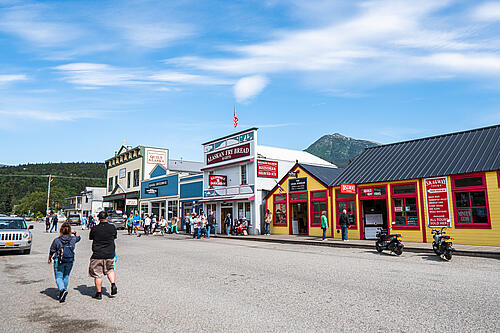
One mistake I see many first time Alaska cruisers make is packing clothes more suited for Antarctica than southeast Alaska. As shocking as it sounds, you can feel uncomfortably warm on an Alaska cruise in the middle of summer.
In fact, my most recent Alaska cruise in mid June had me sweating more often than shivering. I could not believe the high temperatures we encountered—in Juneau it was nearly 80 degrees fahrenheit!
Needless to say, I immediately regretted wasting packing space with several sweaters, pullovers, and jackets. Most warm layers went unworn during the cruise, and I found myself in need of a lightweight t-shirt to avoid overheating!
Related: Alaska cruise packing list: What to pack for your sailing
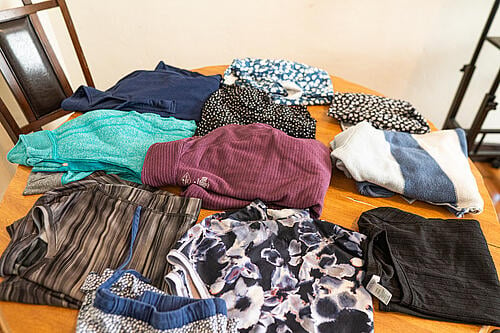
If you’re cruising to Alaska in the middle of summer, I would avoid packing an excessive amount of warm layers. There’s no need to pack a parka, wool socks, and extreme weather gloves. While you should definitely still pack a few warm outfits, be sure to pack lightweight layers like t-shirts, long sleeve shirts, and, yes, maybe even a pair of shorts.
If you’re cruising to Alaska during the shoulder season (the beginning or end of the season), disregard this advice: you’ll definitely want the majority of your suitcase to be warm layers.
Assuming balcony rooms are necessary

Many first time cruisers to Alaska are under the assumption that they must book a balcony cabin for an Alaska cruise. Having a balcony cabin means you can enjoy Alaska’s scenery from the comfort of your stateroom, so it’s an extremely popular cabin choice on Alaska itineraries.
Booking a balcony cabin is certainly nice, but it’s not necessary in order to enjoy an Alaska cruise. I’ve cruised in an interior cabin on all five of my Alaska cruises, and I have no regrets about this decision.
Related: Interior vs Balcony staterooms on a Royal Caribbean cruise
One of the unique aspects of cruising Alaska is sailing through the narrow inlets of the state’s Inside Passage. As your ship travels through Alaska, you can view the state’s huge mountains and islands on both sides of the ship.
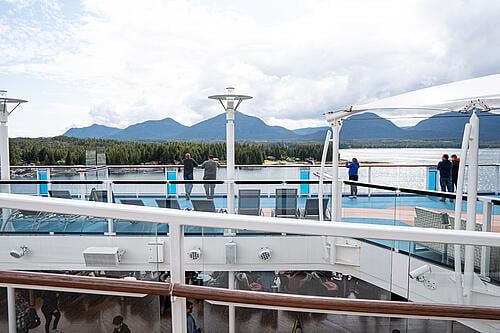
Most balconies only have views of one side of the ship, meaning that by watching scenery from your balcony, you are missing out on half of the scenic views! Because of this, many cruisers find themselves heading to the pool deck or the helicopter pad anyway in order to have a wider view of the outdoors.
If a balcony room is in your budget, there’s no harm in booking one for an Alaska cruise. If it’s a stretch for your bank account, book an interior room and allocate additional vacation savings towards add-ons like shore excursions instead.
Eating dinner in the Main Dining Room during sailaway
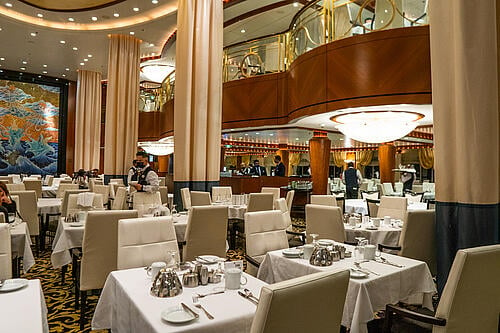
Enjoying meals in the Main Dining Room is a staple part of any cruise vacation, but I hardly ever eat in the venue on Alaska cruises.
The Main Dining Room on Royal Caribbean ships is a gorgeous space, with most ships featuring a multi-story, opulent dining venue. However, there are limited tables by the windows, so only a small percentage of passengers dine with a window view.
While your ship sails through Alaska, you’ll want to be near a window or outside view as often as possible. If you have early dining, which is around 5PM, your dinner may coincide with the sailaway in Alaska’s cruise ports.
Related: Dinner on Royal Caribbean: Early Dinner vs. Late Dinner
Some of the most beautiful cruising occurs as your ship leaves port. The sailaway in Skagway, as an example, travels through the Inside Passage for several hours, passing massive glaciers and mountain ranges along the way.
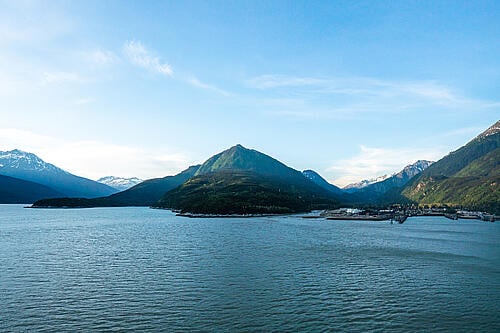
If you’re eating in the Main Dining Room during sailaway, there’s a good chance you’ll miss some of the best scenery of the trip.
If your ship’s sailaway is at the same time as dinner, I recommend skipping dinner in the Main Dining Room and eating at the Windjammer buffet instead. Unlike the dining room, the Windjammer has large windows around the whole venue, allowing you to dine with a panoramic view of Alaska’s scenery.
Waiting too long to disembark the ship in port
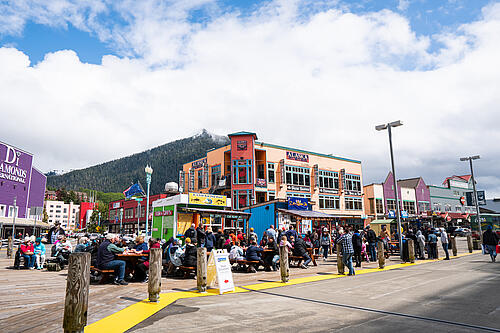
One of the biggest mistakes I see passengers making on Alaska cruises is waiting too long to disembark their ship in a port of call.
Generally speaking, the earlier you disembark your cruise ship on a port day, the fewer crowds you’ll encounter in port. It’s not uncommon for there to be four or five cruise ships in busy ports like Juneau, which means 10-15,000+ passengers may disembark their ships on any given day.
Related: Local's guide of what to do in Juneau, Alaska
Alas, Alaska’s small, quaint cruise ports can feel crowded quickly, with peak crowds appearing around 11AM - 1PM. As passengers finish a morning shore excursion or disembark the ship after sleeping in, most walk the streets of each port's downtown, leading to higher crowds.
If you want to beat the crowds on an Alaska cruise, disembark your ship as early as possible. While this might require setting an alarm earlier than you would prefer, it’s worth it for the early morning exploring without the crowds.
Only considering roundtrip itineraries
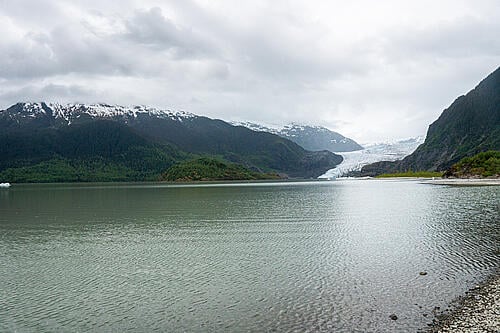
There are two options when it comes to Alaska cruises: one-way itineraries and roundtrip itineraries.
Roundtrip itineraries travel roundtrip from either Seattle, Washington or Vancouver, British Columbia, starting and ending in the same port. One-way cruises, on the contrary, travel in one direction—from Vancouver to Seward, Alaska and vice versa.
Many first time cruisers to Alaska book a roundtrip itinerary for convenience. In most cases, it’s easier to start and end in the same port, as it makes booking flights and/or driving to the cruise port much easier.
Nonetheless, one mistake I see passengers make on an Alaska cruise is only considering roundtrip itineraries. Of my five Alaska cruises, I sailed on four roundtrip sailings and one one-way cruise. The one-way cruise was, by far, the better itinerary.

A one-way cruise allows you to visit more ports and glaciers in Alaska, including those that are further away from the lower 48 like Hubbard Glacier. Additionally, traveling in one direction means you can extend your trip in Alaska’s interior to visit sites like Denali National Park & Preserve.
Before booking an Alaska cruise, be sure to consider the pros and cons of a one-way itinerary over a roundtrip sailing.
Not researching what to do before arriving in port
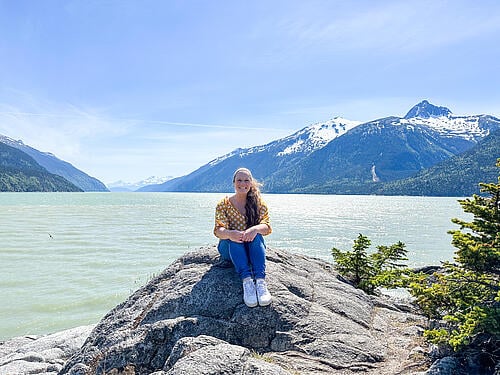
Each Alaska cruise port offers its own set of must-sees and dos, and one of the worst mistakes you can make when planning an Alaska cruise is not researching what to do in each port.
On my recent cruise to Skagway, I planned to hike to Yakutania Point, a lookout point with a stunning view of the Taiya Inlet. When it came time to disembark in port, I realized I had not yet researched how to get to the trailhead, and upon reaching town, my phone had no cell connection.
An emergency trip to the local library for wifi eventually led me to finding the trailhead, but I wished I had done more research ahead of time to avoid this unexpected scenario.
While you don’t have to book excursions in every port, we still recommend having a general idea of what to expect in each Alaska port. Whether you’re interested in a day hike in Sitka or museum visit in Ketchikan, it’s a lot easier to research things to do before you disembark the ship in port.
Eating only on the ship
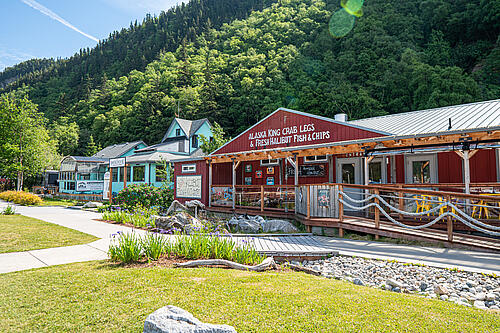
Alaska is home to delightful, fresh cuisine—the state is famous for its fish, king crab, and reindeer meat. If you’re a seafood lover, one of the worst mistakes you can make on an Alaska cruise is eating only on the ship to avoid paying for food in port.
Although most food on a Royal Caribbean cruise is complimentary, I always suggest budgeting for a meal in port. Whether you grab a few fish tacos from a food truck or enjoy a sit-down meal in port, spending ~$20 for a tasty meal of Alaskan specialties is well worth the cost.
Related: Where to eat like a local on your Alaska cruise
Flying in the same day the cruise begins
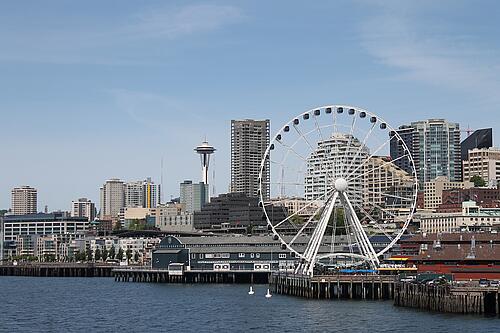
Like any cruise destination, a huge mistake many passengers make is flying to their embarkation port the same day the cruise begins.
I always fly to my cruise ports the day before my cruise. Arriving a day early eases the stress of travel by ensuring I have enough wiggle room in the case of flight delays or cancellations.
Related: The costly cruising mistakes newbies make planning their first cruise
Not only that, but arriving early means I can enjoy a day in Seattle or Vancouver before my Alaska cruise. I always take this time to dine at a nice restaurant, go for an evening walk, and catch up on rest before embarkation day.
Time and time again, I see passengers booking flights the same day as their cruise. Not only is this risky, but it makes the first day of your cruise extra stressful. Instead of spending embarkation day sipping a cocktail stress-free, you’ll most likely be jet lagged and ready for a nap.
Forgetting binoculars
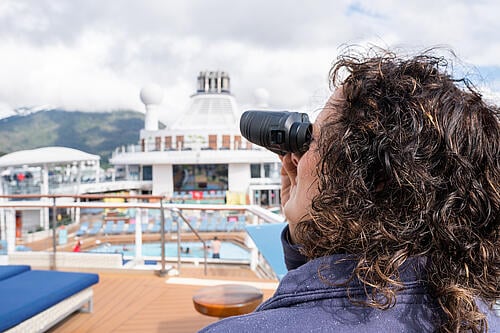
You can only get so close to Alaska’s scenery and wildlife while visiting on a cruise, but using binoculars makes you feel so much more connected to the state’s magnificence.
A common mistake many passengers make on an Alaska cruise is forgetting to bring binoculars. You can find a cheap pair of binoculars on Amazon for around $30, and believe us: it‘s well worth the small cost.
Related: What should you bring on an Alaska cruise?
I spend an embarrassing amount of time looking through my binoculars on an Alaska cruise—I’m on whale watching duty, as I like to call it. Whether spotting whales or viewing glaciers close-up, binoculars undoubtedly make an Alaska cruise more immersive.
Not using Port Valet in Seattle
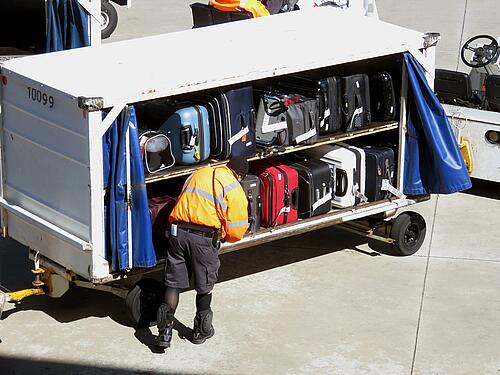
If your Alaska cruise ends in Seattle, you should take advantage of the port’s luggage valet program.
Luggage Valet is a helpful, complimentary service offered by the Port of Seattle and Seattle-Tacoma International Airport. This service enables passengers to bypass check-in and baggage drop at the airport by completing these steps on their cruise ship instead.
If you sign up for luggage valet, you will receive a luggage tag near the end of your cruise. When you place your suitcase (with the luggage tag attached) outside your cabin door on the last night of the cruise, you will not see the suitcase again until you arrive at your home airport.
Luggage Valet transfers your suitcase directly from the ship to the airport and onto your plane. There’s no need to travel from the cruise terminal with the luggage yourself, and this is a huge time (and stress) saver for many passengers.
You can enroll for the service ahead of time or once onboard—a sign up sheet will be delivered to your stateroom during the cruise.
Waiting too long to book a shore excursion

If you wait to book a shore excursion until you're on your ship, you're making a big mistake.
Alaska shore excursions sell out quickly, and more people are booking them before the cruise begins than ever before.
Tours offered by Royal Caribbean are in short supply, and slots fill up fast. Once you get within 4-6 months of your cruise, you can expect tours to start selling out.
What you should be doing is booking your excursions as early as you can. Ideally, at least six months before the sailing.
Skip third party excursions

Just as problematic as waiting too long to book an excursion is overlooking tours sold outside the cruise line.
Alaska is one of the best places to book a tour with an outside company because it's part of the United States, everyone speaks English, and you could save a lot of money.
Check out our list of Alaska shore excursions our readers swear by as reputable and really fun.
Not buying travel insurance

You never know what might happen while in Alaska, and it's why it's so important to buy travel insurance.
All too often cruisers skip it to save money, or just out of ignorance. Regardless, it's a big mistake because of the risks with travel. You could slip and fall, your flights might get cancelled, or you might get sick.
Travel insurance is something I recommend for everyone on every cruise to buy. It's more than just medical coverage, as travel insurance plans cover unforeseen circumstances and issues you may run into before, during, or after the cruise.
Overpacking for evenings

Because an Alaska cruise is so port intensive, dinners on a Royal Caribbean cruise are secondary.
In practice, most people dress far more casually for an Alaska cruise on Royal Caribbean. While I can't speak for other lines, I can tell you it's a mistake wasting a lot of luggage space on formal outfits for dinners when going to Alaska.
That isn't to say you should dress like a slob to dinner. Rather, don't over think it. You can skip the formal wear and pack outfits you can re-use or mix and match to save on space.
Not to mention packing less means potentially saving on luggage costs when flying with the airlines.
Not planning for getting seasick

You probably won't get seasick, but it can happen on an Alaska cruise, especially if your sailing goes through the Gulf of Alaska.
The Pacific Ocean can get plenty rough during the summer. Luckily most of the cruise occurs within the Inside Passage, but there's still the risk of getting seasick.
Pack seasickness medications with you, just in case the motion in the ocean hits you. I've seen posts from too many people complaining they got so seasick when they could have avoided the worst of it by having the right medicine with them.
Not spending enough time outdoors

Even in the summer, Alaska can get cold. But you really ought to suck it up in order to enjoy what you can see that surrounds you.
Often I see cruisers focused on the indoor activities, and totally missing out on what's happening outside.
Pack the right jackets, sweaters, hats, scarves, and gloves so you can be outside and see the thing you came to Alaska to see in the first place.
The best spot to go are the top decks of your ship, and that's also going to be the windiest locations. Having the right clothing makes a big difference, and you don't want to miss out on a passing whale, soaring eagle, or incredible mountain range.
Skipping the visitor centers

Each port has a visitor bureaus you can visit for free, and it's really a great starting point if you've never been to that city.
These visitor centers can help with referrals and recommendations. You'll get great info from Travel Juneau, Visit Ketchikan, and Skagway Visitors Center.
Not trying the White Pass Railway at least once

If you're worried the White Pass Railway is a tourist trap, fear not. It's probably the Alaska shore excursion to try.
This is an authentic gold rush era train that takes you from Skagway into the Alaskan wilderness. You can book the train roundtrip, or with a bus ride to/from the station.
Inside the train car are large windows to view Alaska's scenery.

The ride starts by passing through Skagway and the historic Gold Rush Cemetery near town. It continues along a river and begins to gain elevation. The guide onboard highlights interesting points along the way, telling the history of Skagway's role in the Gold Rush era.
More Alaska cruise tips:
- How to choose the right Alaska cruise itinerary
- Alaska cruise whale watching guide & tips
- How far in advance to book an Alaska cruise
- What is the best time of year to see wildlife in Alaska?
Pin this blog on Pinterest








